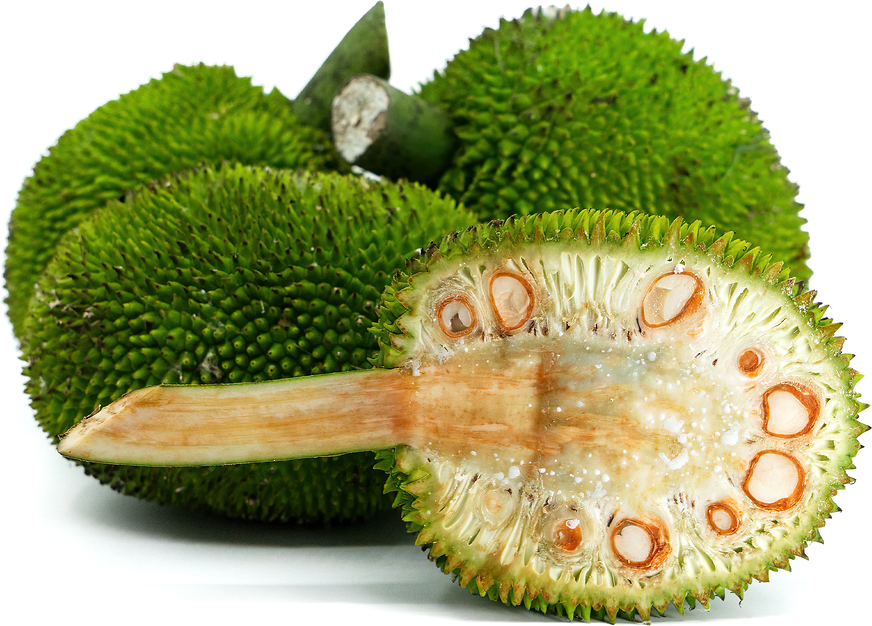


Kamansi
Estimated Inventory, lb : 0
Description/Taste
Kamansi, a tropical fruit with an oblong shape, bears a resemblance to a mango and can grow 10 to 25 centimeters in diameter. It begins with a vibrant green exterior that gradually shifts to brown as it matures. Its surface is adorned with spiky protrusions, echoing the appearance of a jackfruit. Inside, Kamansi reveals a soft creamy white flesh that encases relatively large seeds that account for nearly half of the fruit's weight. The aroma of Kamansi is subtly earthy, with faint undertones reminiscent of freshly baked bread, as its name suggests. When ripe, it offers a starchy and nutty flavor.
Seasons/Availability
Kamansi is usually harvested between late summer and early fall.
Current Facts
Kamansi fruit trees, botanically classified as Artocarpus camansi and belonging to the Moraceae family, are cultivated primarily for the edible nuts housed within its fruit. Contrary to popular belief, Kamansi is not a type of breadfruit; instead, it is the wild ancestor from which the breadfruit was domesticated. Widely known in English as the Breadnut, Kamansi has various names across different cultures, including Castaña, Chataigne, Chataignier, Dulugian, Kolo, Ugod, Kapiak, and Pana de Pepitas. Kamansi has been used for centuries as a culinary ingredient. Both the flesh and seeds are edible, but the seeds are revered for their versatility, taste, and nutritional value. Historically, Kamansi was reserved as a wild species, but over time, the trees were planted in home gardens and utilized on a small scale for commercial purposes.
Nutritional Value
Kamansi seeds are low in fat and high in protein. Kamansi is notably rich in niacin, a vital nutrient that plays a key role in metabolism, supports skin health, aids the nervous system, promotes digestive health, and benefits cardiovascular health. These seeds are packed with essential minerals, including calcium, magnesium, potassium, iron, and zinc. They contain amino acids such as leucine, methionine, serine, and isoleucine, further enhancing their nutritional profile.
Applications
Both the pulp and seeds of Kamansi fruit are edible, though the fruit is primarily valued for its seeds. These seeds can be roasted, boiled, baked, or eaten raw. Kamansi seeds can be preserved in brine, made into nut butter, oils, paste, and flour. The pulp and seeds from the immature fruit are edible when cooked and can be added to soups, stews, and curries. Kamansi seeds can be mashed with butter, incorporated into stuffing, or glazed with sugar syrup to create a "breadnut glacee." Their versatility extends to recipes traditionally calling for chestnuts, where they can be thinly sliced and cooked as a vegetable, particularly in Filipino cuisine. To maintain their freshness, Kamansi fruit should be stored in a cool, dark place until it's time to eat them.
Ethnic/Cultural Info
In the Philippines, the pulp and seeds of unripe Kamansi are frequently accompanied by pork, coconut milk, and chili peppers. The nutritionally rich seeds of Kamansi are ground into flour, which is then used in the commercial production of nutritionally enhanced cookies. This innovative use of Kamansi flour indicates a wider movement towards harnessing underutilized crops to bolster nutrition and food security. The dissemination of Kamansi across its native habitats is facilitated by fruit bats and tree-dwelling mammals, which play a crucial role in the natural propagation of this plant.
Geography/History
Originating from New Guinea and Indonesia, Kamansi fruits thrive in both tropical and subtropical climates, favoring abundant sunlight and well-drained soil. The Kamansi tree is commonly cultivated in the Philippines, where it adorns many home gardens as a backyard tree. It flourishes in the wild within alluvial forests of lowland areas, where its propagation is aided by birds and fruit bats. During the 18th century, the Breadnut was distributed across the tropics and has since become prevalent in regions such as the Caribbean, Central and South America, Southeast Asia, and West Africa. Kamansi is readily available in local markets and specialty stores within its native tropical habitats. Beyond these areas, it may be found in Asian or international grocery stores, particularly those specializing in Filipino or Southeast Asian cuisines.
Recipe Ideas
Recipes that include Kamansi. One
| The Peach Kitchen |
|
Ginataang Kamansi/ Seeded Breadfruit in Coconut Milk |




